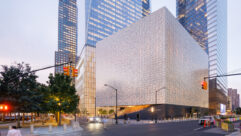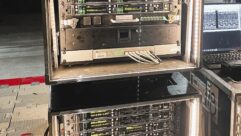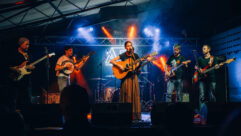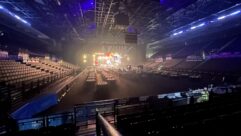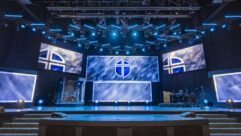
SVC: Can you describe the Garland Theater? What were the problems they had with the old AV system?

Lewis: I actually remember attending movies there as a student. So it was a lot of fun when we got the call to go up there and look through the AV system that had been there since the late 1980s. The system had certainly done its job, but we found it to be a little lacking, particularly in the subwoofers, things like that. The surround speakers were showing a lot of age and an older amplifier. So we just looked at it from the standpoint of upgrading every- thing we could within the client’s budget and desires. The owner, Kathy, and her manager, Tana, made a decision about three years ago that they were going to keep the theater open; it is an independent theater here in Spokane, one of the last ones and one of the largest, seating over 600. We had worked with them to keep the old system running until they finally said, “We’re going to redo everything.” And they did a beautiful job: new video source, new audio and they redid the entire interior.
Anyplace that’s described as having historic architecture, you may have some problems. So were there any special challenges with the building itself on cabling and rigging and all that?
The nice thing is their attic space is totally walkable. It has full lighting up there, which was wonderful. We were able to pull all the cable; and a lot of the cable existed from the previous system. However, hanging new surround sounds and adding surrounds and rear fill, every wall was a new experience in finding out what was behind the creep that had been formed over the wall. There was red brick in spots. There was nothing in spots. So every time you thought you had the answer on how to hang things to those sidewalls and rear walls, you’d get three or four surrounds up and all of a sudden you’d pop through the wall and find out you’ve got to go back and rethink this. Of course the safety factor is number one, so we had to figure out “how far do we have to go back to find something that we can sink into so we’re sure nothing is going to ever come down?” The surrounds took a couple more days to put up than I imagined, but I feel good about them and we did some safeties. But yeah, it was an interesting adventure there for a couple of days.
I know that one of the problems with the old AV system is that it was made up of separate components and there was a pretty complex power up and powering down sequence that had to be followed to get everything activated in the right order. I think they had to have a written checklist to go by. What new capability did the Furman 2400s Smart Sequencer give them? I guess it made that job a lot easier?

Oh, yeah. That was one of the things they showed me the first time I visited there. The system had a typical handwritten note taped to the side of the rack describing how you turn the system on, and this is how you turn it off. Every new projectionist, if you will, had to be trained in that. They were still running the old 35 mm films and then feeding this system. So one of the requests was to make this easier for my staff? And so I chose the Furman. I had a good rapport with them. I’ve had really good luck with their products in all of my church projects and other projects, so it was just a natural. When we got the new system in, took the staff up to the booth, of course the first thing was, “How do we turn all this on?” I reached up to the top of the rack, turned one silver key, and the thing just sequenced itself on. And they all stood there and looked at me and I said, “That’s all you have to do. When you want to close for the night, you reach up there and turn it the other way and it will turn itself off.” The owner was really happy to do away with the notes taped on equipment, and there was no more wondering what got left on overnight, things like that.
I know you put in a lot of speakers. Subwoofers, that seems to have been the biggest job from the pictures I saw. What new types of speakers did you put in?
The system that was there from the 1990s were JBL speakers and Crown amps. Of course with Harman owning all of those companies now we talked to Chuck Goodsell at Cinema. I worked with Jon Sager and Jay Fullmer down at JBL Pro for many years on projects. So I contacted them and said this is what they’ve got. Is there anything that I can salvage to help with the budget? We went through all the parts and pieces. Kept the double 15s — they were in good shape — behind the left, center, right of the screen. And then replaced and updated the high components in that. There was only one double 18 sub behind the screen. For that big a room, we added more of the 4642s by JBL. It’s still an all-JBL system. And when I was going through things behind the screen – where there is a big, open, hollow stage — I found boxes with 18s in them, which kind of made me question what was going on. I flipped it over and discovered that they had seized up the original drivers and just stuck a generic driver in there. So we quickly ordered new drivers from JBL to get that cabinet back where it should be and added three. Because of that big, hollow cavity, I put that into a subcardioid pattern and got some of that energy going forward and boy, it just made a difference in that room. And there are 14 of the CBT70s in that room now, including the rears, and those things just produce like a son of a gun. I’m just really pleased going with the CBT for the surrounds and the rear fill.
They have the control capability. Where is the sound control point located?

Everything is in the projection booth and the audio rack beside the new projector. Then using the Datasat AP20 we fine-tuned it. They do use a DVD player, a computer input, because they use the room for more than just cinema. They rent the room during the week for business meetings, anything in the area. Schools have meetings there and even graduation there. So we do have some live capability as well.
Because of that need I think you put in a Soundcraft EPM mixer?
Yes, that had gone in even before the change. They had a little mixer there that was a consumer piece and they were trying to feed a wireless mic through it for these meetings and things even before we did the change. So that Soundcraft went in earlier and then of course I just kept it. It’s a great little piece. It fits on a rack shelf so that they can access it. It’s straightforward to use for the different staff members that help them do these meetings during the week. Again, the AP20 is a simple touchscreen, so they look at the buttons across the touchscreen and if they want to go to live we have it listed as just mixer. They hit that and the mixer comes up. They can use anything through that mixer live and then go right back to 7.1 or 5.1 as they need to.
I think they already had a projector in there. Was that a Christie unit?
Yes. The owners did this in three to four phases, and once they had reviewed where they wanted to go with the theater, the Christie was one of the first things they put in. Hoffman didn’t do that; another cinema projection company here in the Northwest did that for them. But that was kind of the catalyst. They got comments from their patrons that it made a big difference. And doing movies all-digital was the push to say okay, what else do we want to do?

So they already had great projection and this new sound system really got the audio end of things up to that level. Since there are live events, changes would have to be made at the control point. Are there some presets they can recall to go between movies and live events?
The Datasat AP20 handles that for us up front because it has the touch screen capability to jump between live and the 7.1, 5.1 from the projector unit. And then they still have a DVD/Blu-ray for custom showings of small movies and even television announcements. They have an off-air capability, and then we left an HDMI input for a computer input – for live presentations where somebody wants to do a Power Point. So that’s all handled by the Datasat by pushbutton. Then along with the Soundcraft, if you go to the live setting, you have control of the audio as far as a wireless mic and a couple of inputs for the computer for playback.
How are the acoustics in that place? In a theater they’re supposed to be good but things deteriorate over that much time. Was any acoustic treatment needed or is that something that’s still on the list of things to do?
That would be down the road. I would love to do some, although I have to say with the new seats and the new carpets, it certainly has calmed things down. But the walls and the ceiling are a spread out concrete over brick. So everything in there, if you go up and knock on the wall or feel a wall, it feels like concrete, including the ceiling. So there can get to be some pretty good rolls back and forth and a wave problem between the two parallel walls. So the depth and the varying height in the room help to break that up. That was another reason in going to the CBT70s for fills—with the asymmetrical pattern on those, we could point them down and keep them in the seat- ing area and try to keep some of the reflection from bouncing between walls along with the left-center-rights on the front. Again, that was part of choosing to put the subs into a cardioid pattern; not so much wanting a power alley up the center, but to get things pointed forward and stop the roll from behind the screen. It’s a pretty good- sized stage behind that screen and it’s just a big empty cavern right now. So anything that goes back there bounces around and eventually comes back through the screen. The great thing was the only request I’ve had from patrons is can we turn the subs down a little bit. Well, we can always turn things down.
And you only had a couple of days to get this done.

Yeah, when they finally got the seat- ing torn out and changed, and the carpets were going in, they contacted me and said okay, we made our decision. So this is April, and I asked when it has to be running. They said: “Well, we’re going to celebrate our 70th anniversary and we’d like to have everything completed by June 6.” Okay. For hanging speakers, we could go in mornings, or when the theater was closed, and just change them out. Did it sound funny? I’m sure it did because we were running with the old rack and we just balanced it the best we could every day to keep them running for their projection time or their cinema time. And then the weekend before their celebration, they closed down at midnight after the last showing and we had a day and a half to change that rack out.
So not much time and much to do. And you always wonder if you’re going to hit some major snag that causes everything to back up.
Yeah. That was the great thing about the presets from JBL and Crown. We were able to download and insert all of the DSP directly for the cinema processing, left, center, right and subs, which made that setup go extremely quickly. And I chose to fly down to Datasat in Simi Valley and spend a day with them, and they trained me on the new AP20 so I could just put it in, get them on the phone and have an idea of what I was dealing with beforehand. The theater was only down for one night during the changeover.


